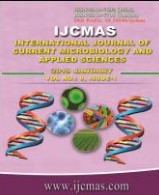


 National Academy of Agricultural Sciences (NAAS)
National Academy of Agricultural Sciences (NAAS)

|
PRINT ISSN : 2319-7692
Online ISSN : 2319-7706 Issues : 12 per year Publisher : Excellent Publishers Email : editorijcmas@gmail.com / submit@ijcmas.com Editor-in-chief: Dr.M.Prakash Index Copernicus ICV 2018: 95.39 NAAS RATING 2020: 5.38 |
Tuberose (Polianthes tuberosa L.) occupies a very selective and special position among the ornamental bulbous plants which are valued much by the aesthetic world for beauty and fragrance. Tuberose is cultivated in large scale in many tropical and subtropical countries including India. It is an important cash crop in India and commercial cultivation is taking place in Karnataka, Andhra Pradesh, Tamil Nadu, Maharashtra and West Bengal. During 2014-15 total area under tuberose in India was 6.82 thousand hectares producing 42.74 thousand MT and 5.93 lakhs pikes (Anonymous, 2015). Comparatively low productivity in West Bengal is attributed to incidence of pests including nematodes besides other problems. Farmers are often unaware of losses caused by nematodes infestation because the damage is so subtle that it goes unnoticed or is attributed to other causes. In this study an attempt has been made to study incidences of different soil borne nematodes and model nematode incidences using various parametric trend models in tuberose cultivation using experimental data during 2014-16. The study reveals that not all abiotic factors are equally significantly associated with the incidence of different soil borne nematodes. Among various parametric trend models mostly polynomial trend models are well fitted except in a few cases where exponential trend models are fitted to nematode incidence in tuberose.
 |
 |
 |
 |
 |